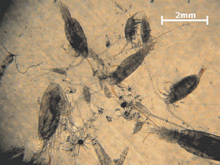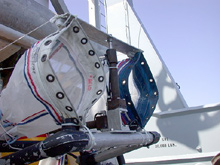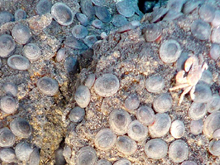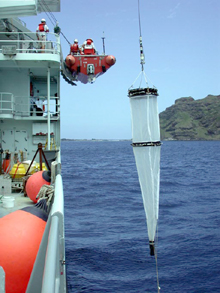
Some common zooplankton (mostly copepods) collected near the surface over East Diamante Volcano. Click image for larger view.
Tiny Inhabitants of the Deep
April 14, 2004
Anna Metaxas
Assistant Professor, Department of Oceanography
Dalhousie University
John Dower
Fisheries Oceanographer
University of Victoria, Canada
Plankton are the microscopic animals (zooplankton) and plants (phytoplankton) that drift in the ocean. Although they occur at all depths, plankton are most abundant near the surface, where there is enough light for the phytoplankton to photosynthesize. At hydrothermal vents, the plankton community usually also includes the larval forms of the bottom-dwelling species found near vents, such as crabs, shrimp, worms and snails. These larval forms may drift in the water column for days to months before settling back to the bottom, and are the main means by which new vent sites are colonized.

These plankton nets are mounted on the bumper bar of the ROPOS remotely operated vehicle, and are used to collect plankton above the hydrothermal vent sites. Click image for larger view and more details
We have made some interesting observations at the various seamounts visited on this expedition. At NW Rota 1, where we observed intense venting, plankton were relatively abundant at 30-40 m (~114 ft) above the bottom. No plankton were found immediately above the thick plume, perhaps because the chemical composition of the plume may be too toxic for these creatures. At East Diamante we saw the opposite pattern: the plankton were more abundant directly above the chimneys (where they were exposed to hydrothermal fluids), while abundance 30 m (98 ft) above the bottom was quite low.

Conical limpets (2cm, 0.75 in) cover the rock surfaces at East Diamante. The white dots on the rocks and shells are limpet egg cases. An arc crab investigates the scene. Click image for larger view.
The most interesting finding has been the complete absence of larval forms of vent animals in our samples. It may be that the vent species on these seamounts produce larvae that spend only a brief period in the plankton form. For instance, larvae of the limpet Shinkailepas kaikatensis (which we collected from egg cases laid on rocks at vents) seem to be quite short-lived, suggesting that they do not drift very far before settling back to the bottom. Similarly, the eggs we collected from the vent mussels at NW Eifuku appear to be denser than water, so they sink rather than float. Thus, the absence of larvae over the vents may indicate that other abundant organisms at these vents (such as barnacles and other snails) have short-lived larvae, too. Interestingly, we have also observed clockwise currents over most of the seamounts that we have visited. Such currents tend to trap plankton over seamounts and may further enhance the retention of these short-lived larvae.

This plankton net is being deployed to collect near-surface plankton in Maug caldera. Click image for larger view and more details.
Another unusual aspect of the Mariana Arc volcanoes is that hydrothermal venting (usually confined to the deep sea) can also occur near the surface. At East Diamante and Maug, venting occurred at depths shallower than 200 m (650 ft). This creates the potential for vent-associated species to interact with the “normal” plankton community of the near-surface layer (something that has not been seen elsewhere). It is possible that the bacteria and organic material associated with venting may increase the food supply available to plankton over these seamounts. Similarly, since many of the zooplankton in this part of the Pacific swim up to the surface each night and down again each morning, they may be preyed upon by vent-associated predators (e.g., crabs, shrimp) at these shallow vent sites near the tops of the seamounts.
Sign up for the Ocean Explorer E-mail Update List.



























